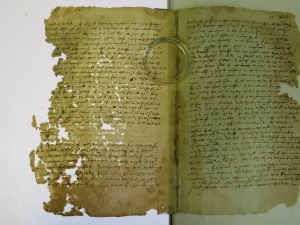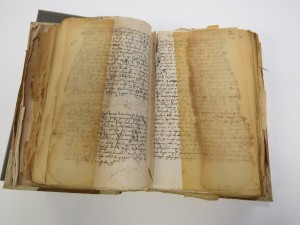Initial survey
An initial survey revealed the scope of the project – all 28 springback volumes require considerable paper repair as well as surface cleaning, some of them, particularly those 8 volumes previously repaired using Glassine, require more extensive investigation. Each volume was documented and photographed. A treatment plan was also devised for each volume.
Further investigations required:
Preferred techniques and materials for the new paper repairs
Feasibility of removing old paper repairs
Conservation techniques for Springback bindings
Most of the volumes have been repaired previously, it may be necessary to remove old repairs and replace them with conservation grade materials but only when the old repairs are causing mechanical and or chemical damage
All but three of the Springback bindings are in good condition and fully functioning, so extensive paper repair will need to be carried out in situ.
Tests were carried out into best paper repair methods. Use of remoistenable Japanese papers (Tengujo) for support verso, and Kozo 23g for infills made with adhered with wheat starch paste were found to be most effective at supporting water and mould softened paper
K
The paper substrate varies in condition from good to very weak and softened by water and mould damage. There is discolouration apparent and tideline formation throughout all vols, plus visible mould growth now dormant. There is evidence of some minor Iron Gall Ink burn, but the manuscripts remain clear and legible. Losses are confined mainly to the volumes treated with Glassine, mainly along the fore edge. These losses had already occurred by the time the Glassine repairs were made. The Glassine appears to have been applied at the same time as the volumes were rebound in 1874.
The Glassine repairs are clearly causing both mechanical and chemical damage to the substrate, but given that the substrate was already softened by water and/or mould damage before the glassine was applied, is it even possible to remove the glassine without causing further damage, skinning, lifting text away from powdery paper?
The Glassine repair paper is itself is not ageing well, becoming extremely brittle, hard, darkening to brown. It is obscuring large swathes of text, preventing effective copying and digitisation. The weight of the double thickness glassine, folded around each fore edge, is making handling hazardous, creating weakness along joins. Often the glassine repairs have come away from the page, taking substrate with them.


